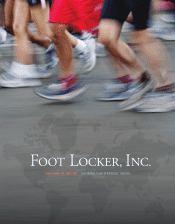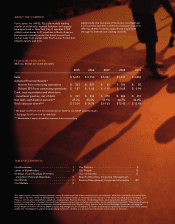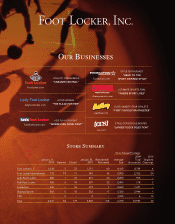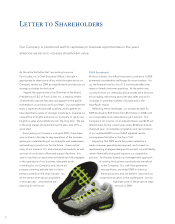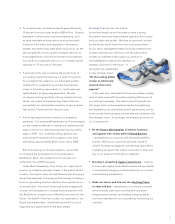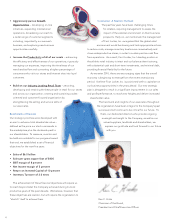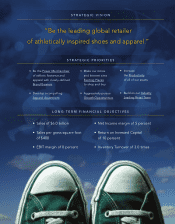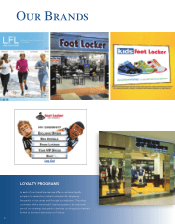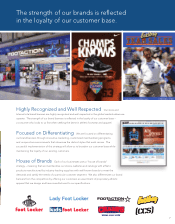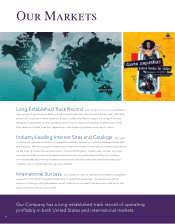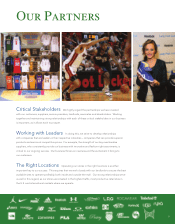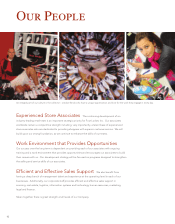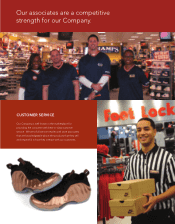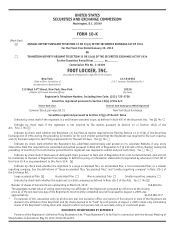Foot Locker 2009 Annual Report Download - page 5
Download and view the complete annual report
Please find page 5 of the 2009 Foot Locker annual report below. You can navigate through the pages in the report by either clicking on the pages listed below, or by using the keyword search tool below to find specific information within the annual report.
• To conserve cash, we reduced capital expenditures by
39 percent from prior year levels to $89 million. Projects
designed to enhance the customer experience, such
as store remodels and relocations to more favorable
locations in the malls, and upgrades to information
systems and technology, were given top priority. As the
year progressed, we also made a strategic decision to
more aggressively close stores that were not projected
to provide an acceptable return on our invested capital,
resulting in 179 closures for the year.
• A second priority was to improve the productivity of
our working capital by reducing our level of inventory.
To accomplish this objective, our merchants worked
closely with our suppliers to purchase merchandise
closer to the selling season and our “quick response”
replenishment program was expanded. We also
conserved working capital by closing underproductive
stores. As a result of implementing these initiatives
successfully, our merchandise inventory at year end was
reduced by 7.4 percent from the prior year.
• A third key objective was to reduce our operating
expenses. Our long-established practice of encouraging
our associates worldwide to identify and implement new
ways to reduce our operating expenses was successful
again in 2009. Our combined selling, general and
administrative expenses and occupancy costs were
reduced by approximately $100 million versus 2008.
Before discussing our future prospects, I would like
to recognize the achievements of my predecessor,
Matthew D. Serra, who retired from Foot Locker, Inc.
at the end of our 2009 fiscal year.
Under Matt’s leadership, Foot Locker, Inc. improved its
position as a leading specialty retailer in the global athletic
industry. Among his many accomplishments was bringing a
disciplined approach to managing the business, including a
focus on generating positive cash flow from operations on
an annual basis. As a result of executing that strategy with
success, the Company is in a strong financial position with
the flexibility to compete more effectively now and into the
future. On behalf of the Foot Locker, Inc. organization, our
Board and shareholders, I thank Matt and wish him much
happiness and good health in the years ahead.
Strategic Priorities for the Future
As we look ahead, we are fortunate to have a strong
foundation and many high potential opportunities to grow
both our sales and profits. We have an optimistic outlook
for the future, which stems from the conclusions drawn
by our senior management team during an extensive and
analytical process we undertook over the past several
months to understand thoroughly our position in
the marketplace today and to develop our
strategic priorities for the future. In
doing this, we established
a clear strategic vision:
“Be the leading global
retailer of athletically
inspired shoes and
apparel.”
In the near term, we believe that we can achieve a higher
level of sales and profits by enhancing the performance of
our existing businesses. Our sales and profit growth over
the longer term can be supplemented by strengthening
and expanding our current brands and assortments, and by
pursuing new business opportunities that are consistent with
this strategic vision. Accordingly, the strategic priorities for
our Company are:
• Be the Power Merchandiser of athletic footwear
and apparel with clearly-defined Brand Banners
– strengthening our position with the leading athletic
brands, offering our customers a broader range of
athletic footwear and apparel, and developing powerful
marketing programs that inspire customers to shop and
buy in our stores and through our websites.
• Develop a compelling Apparel Assortment – creating
a more meaningful private label business, being a leader
in the branded category and strengthening our in-store
merchandising presentation.
• Make our stores and Internet sites Exciting Places
to shop and buy – capitalizing on our strong customer
service model, creating an exciting and consistent
shopping environment, and making shopping easier
and more seamless for our customers by connecting our
channels.
3

